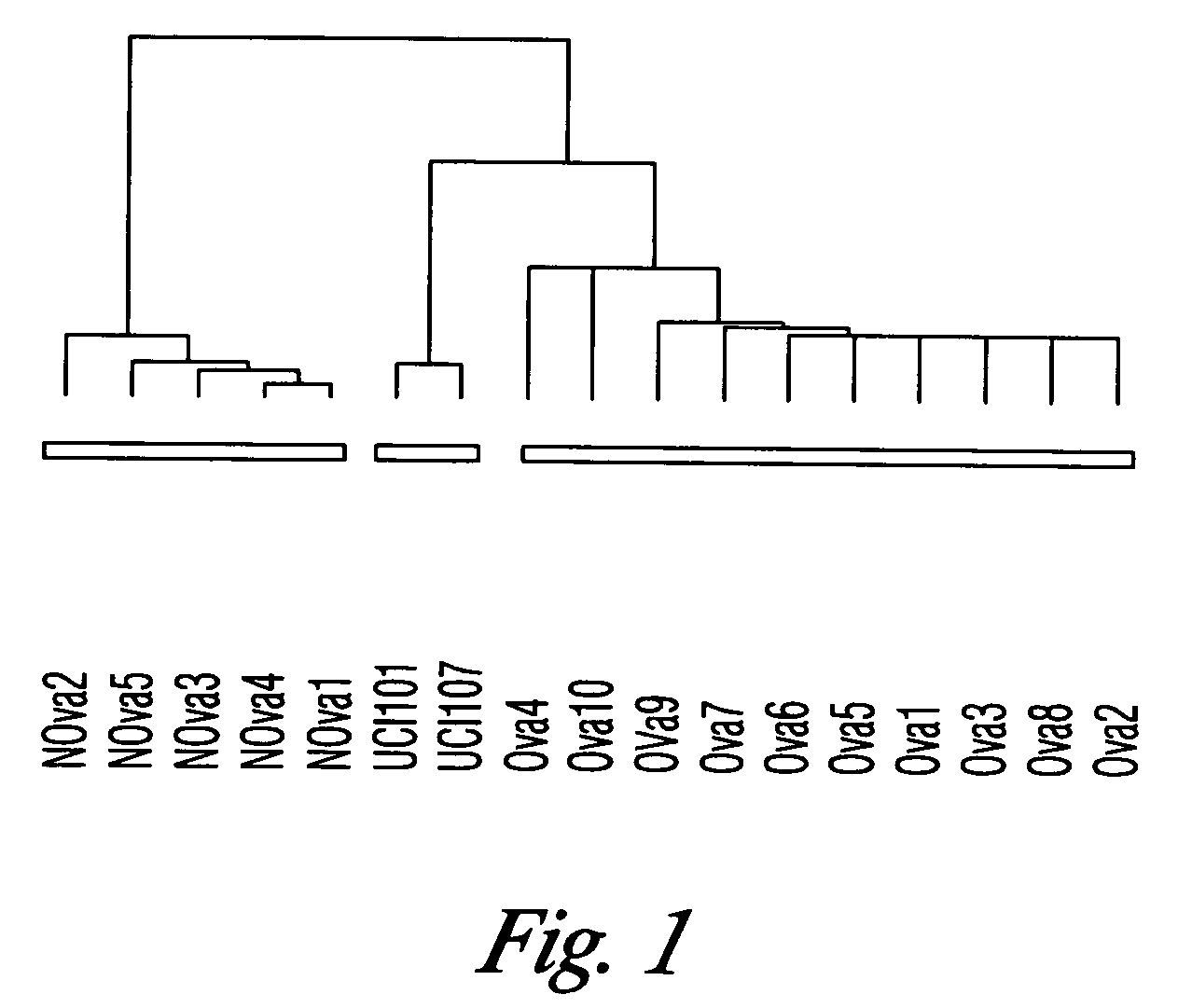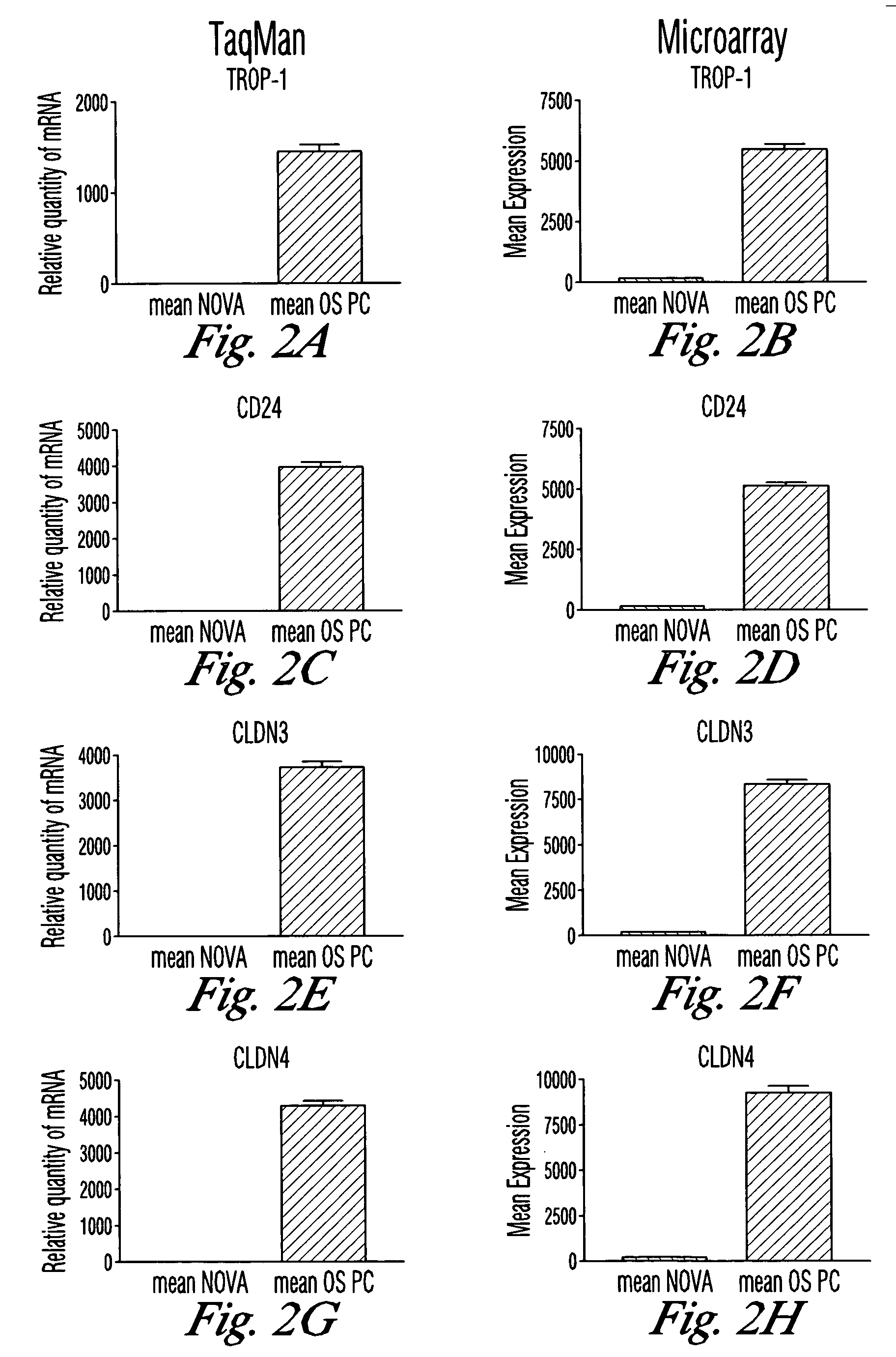Therapy with clostridium perfringens enterotoxin to treat ovarian and uterine cancer
a technology of enterotoxin and clostridium perfringens, which is applied in the direction of antibody medical ingredients, peptide/protein ingredients, and therapy, can solve the problems of chemotherapy resistance, near 90% of patients will develop recurrence, and succumb to their disease, so as to reduce the side effects of cpe, reduce the toxicity of cpe administration, and increase the efficacy against tumors
- Summary
- Abstract
- Description
- Claims
- Application Information
AI Technical Summary
Benefits of technology
Problems solved by technology
Method used
Image
Examples
example 1
Gene Expression Profiles in Primary Ovarian Serous Papillary Tumors and Normal Ovarian Epithelium: Identification of Candidate Molecular Markers for Ovarian Cancer Diagnosis and Therapy
[0153] The goal of this study was to identify genes with differential patterns of expression between ovarian serous papillary carcinoma (OSPC) and normal ovarian (NOVA) epithelium and use this knowledge for the development of novel diagnostic and therapeutic markers for ovarian cancer. Gene expression in 10 primary OSPC cell lines, 2 establish OSPCT cell lines (UCI-101, UCI-107), and 5 primary NOVA epithelial cultures was analyzed by oligonucleotide microarrays with probe sets complementary to 12,533 genes.
Materials and Methods
[0154] Establishment of OSPC and NOVA Primary Cell Lines. A total of fifteen primary cell lines (i.e., 10 OSPC and 5 NOVA) were established after sterile processing of the samples from surgical biopsies as previously described for ovarian carcinoma specimens (30,19,31). UCI...
example 2
Gene Expression Fingerprint of Uterine Serous Papillary Carcinoma: Identification of Novel Molecular Markers for Uterine Serous Cancer Diagnosis and Therapy
[0177] The goal of this study was to identify genes with a differential pattern of expression between uterine serous papillary carcinoma (USPC) and normal endometrial cells (NEC) and to use this knowledge to develop novel diagnostic and therapeutic markers for uterine cancer. Oligonucleotide microarrays were used to interrogate the expression of 10,000 known genes to analyze gene expression profiling of 10 highly purified USPC cultures and 5 primary NEC. mRNA fingerprints readily distinguished USPC from normal endometrial epithelial cells and identified a number of genes highly differentially expressed between NEC and USPC.
Materials and Methods
[0178] Establishment of USPC and NEC Primary Cell Lines. A total of fifteen primary cell lines (i.e., 10 USPC and 5 NEC) were established after sterile processing of samples from surgi...
example 3
Treatment of Chemotherapy-Resistant Human Ovarian Cancer Xenografts in C.B-17 / SCID Mice by Intraperitoneal Administration of Clostridium Perfringens Enterotoxin (CPE)
[0194] In this study, real-time PCR was used to quantify the expression levels of claudin-3 and claudin-4 receptors in several chemotherapy naïve and chemotherapy resistant freshly explanted ovarian tumors. In addition, the ability of CPE to kill chemotherapy sensitive and chemotherapy resistant ovarian cancers overexpressing claudin-3 and / or claudin-4—in vitro was tested. Finally, the in vivo efficacy of CPE therapy in SCID mouse xenografts was studied in a highly relevant clinical model of chemotherapy resistant freshly explanted human ovarian cancer (i.e., OVA-1).
Materials and Methods
[0195] Cloning and Purification of NH2 Terminus His-tagged CPE. Clostridium perfringens strain 2917 obtained from American Type Culture Collection (Manassas, Va.) was grown from a single colony and used to prepare bacterial DNA with...
PUM
| Property | Measurement | Unit |
|---|---|---|
| Fraction | aaaaa | aaaaa |
| Electrical resistance | aaaaa | aaaaa |
| Therapeutic | aaaaa | aaaaa |
Abstract
Description
Claims
Application Information
 Login to View More
Login to View More - R&D
- Intellectual Property
- Life Sciences
- Materials
- Tech Scout
- Unparalleled Data Quality
- Higher Quality Content
- 60% Fewer Hallucinations
Browse by: Latest US Patents, China's latest patents, Technical Efficacy Thesaurus, Application Domain, Technology Topic, Popular Technical Reports.
© 2025 PatSnap. All rights reserved.Legal|Privacy policy|Modern Slavery Act Transparency Statement|Sitemap|About US| Contact US: help@patsnap.com



